Prepatellar Bursitis SymptomsPrepatellar bursitis symptoms are similar to the symptoms of bursitis that occur in other joints in the body; swelling and tenderness, pain, limited range of motion, weakness, and possibly a fever if the bursa is infected. Knee PainYou will experience tenderness just below and over top of the kneecap with prepatellar bursitis. The pain may radiate up your inner knee and thigh and/or down to your mid-calf. Those who suffer from prepatellar bursitis complain of increased pain when crossing their legs or when rising after sitting for several hours. Due to the location of the bursa, pain makes kneeling difficult. Bursitis pain becomes worse during exercise or when you are climbing stairs, but can also increase by simply bending and straightening your knee. Pain usually starts gradually and develops over a few days or even months. Difficulties SleepingPatients suffering from knee bursitis may also have interrupted sleep patterns. Simply bending your knee or rolling over during sleep can cause pressure on the inflamed bursa, increasing your pain. The pain can range from mild to very sharp depending on the amount of inflammation in your knee. Many knee bursitis sufferers recommend placing a pillow between your knees/thighs while you sleep to reduce pain throughout the night. Limited Range of Motion and WeaknessWhen you have bursitis in your knee, regular knee movements can be painful which limits your range of motion. If bursitis is left untreated the inflammation can increase, causing more pain, limiting movement even more and eventually weakness in the leg muscles and tendons can set in. As you lose strength in your quadriceps, your legs may begin to give out during daily activities. Tenderness, Warmth, Swelling and Redness Swelling at the front of the knee is usually evident with prepatellar bursitis and often appears as an abscess on the kneecap. This swelling may appear immediately following trauma, over a couple of hours, or gradually over time as the bursa becomes more irritated. You may also notice warmth and visible redness on your skin in the area as inflammation in the bursa and along the tendons becomes more severe. It is important to treat bursitis in the early stages to reduce these symptoms, minimize tissue damage and maintain motion and strength in your knee. Eliminate any squatting, repetitive knee bending, crossing your legs, kneeling, or any other activities that add pressure on your bursa. By treating your knee bursitis in the early stages with cold and Circulation Boost, you are more likely to prevent long-term damage and chronic conditions from setting in. Prepatellar Bursitis TreatmentsThe most important factor in healing prepatellar bursitis is resting your knee. This can be difficult when you have to carry on with daily activities, but resting whenever you can is recommended. During your recovery you will probably have to modify or avoid the activities that stress your bursa until your pain and inflammation settle. The good news is that most cases of prepatellar bursitis will heal with simple home conservative treatments and surgery is often not neededIt's generally understood by doctors and surgeons that surgery will introduce more scar tissue into the tendons and ligaments in your knee. This added scar tissue will be problematic, requiring visits to the physio clinic and conservative treatment options post-surgery. When it comes to prepatellar bursitis there's only a few surgical options for treatment - removal of the bursa sac, scraping of the bone(s) to allow more room for the new bursa to grow back. This is why surgery is only performed as a last resort for chronic knee bursitis that won't heal with conservative treatment methods. Relieving the pain of your sore knee and the symptoms of bursitis initially focuses on keeping the pressure off the bursa. If your prepatellar bursitis was caused due to the nature of your work, you really need to stop that type of work until the bursitis is gone. For non-infectious bursitis, the preliminary treatment will almost always start with conservative treatment options. Anti-Inflammatory MedicationsNSAIDs, non-steroidal anti-inflammatory drugs, can be used if required to help manage your pain. However, they are not recommended for long term use, as they can cause gastrointestinal difficulties and increase the risk of cardiovascular disease. Many of our customers find they no longer require NSAIDS once they begin using Elbow Cold Compress cold compression and Elbow TShellz Wraps to treat their pain and heal their bursa. During your recovery, you may have to modify and/or eliminate any activities that cause pain or discomfort in your knee joint until your pain and inflammation settle, and you gain more mobility and strength. The more diligent you are with your rehabilitation, the faster you will see successful results. Learn more about Home Treatment Options for PrePatellar BursitisLearn More About Bursitis Injuries & TreatmentsI want to learn more about Post-Surgery Recovery I want to learn more about TShellz Wrap® Circulatory Boost I want to learn more about Ice & Heat: Which Is Better For Treatment? I want to learn more about Bursitis Treatments I want to learn more about Bursitis Surgery FREE SHIPPING ON ALL PRODUCTS CURRENTLY ENABLED | 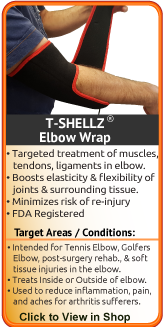  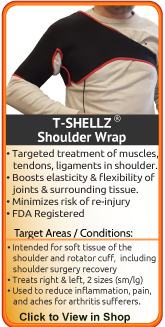  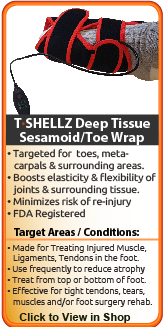 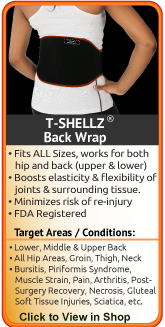  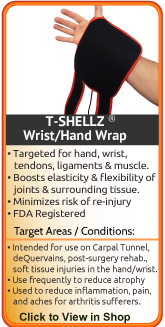 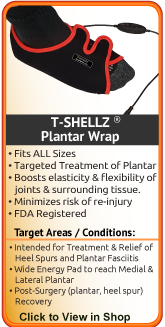  |


